Canada Genealogy Records
| Tweet |
|
Below is a list and description of the most recent genealogy records for Canada (see list of most recent records for other countries). Many of these records can be searched using our free Genealogy Search Engine.
2016 January to June
New Brunswick – FamilySearch.org has created a new browsable image collection of Saint John, New Brunswick burial permits dating from 1889 to 1919. There are roughly 14,000 images in this new collection and each image typically lists four permits. Thus, this collection covers roughly 50,000 burials. The images are organized by date.
A typical burial record in this collection (see image below) lists the name of the deceased, date of death, gender, marital status, spouse’s name (if married), color, age, residence, occupation, place of death, place of birth, name of father, birthplace of father, place of internment and cause of death. Access is free. [Saint John Burial Records]
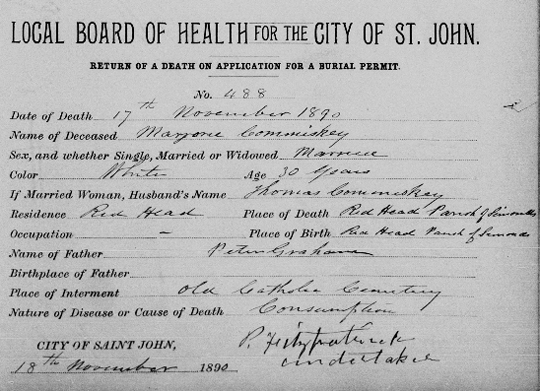
BC – The website BritishColonist.ca has increased their online collection of historic newspapers from Victoria, British Columbia. The collection now spans the years from 1858 to 1950 (the original release only went to 1910) and includes the British Colonist, the Daily British Colonist and the Daily Colonist. These are all essentially the same newspaper that has changed names over the years. It is still published today in Victoria as the Times Colonist.
The most recent addition to the online archive (1941 to 1950) covered some 67,000 pages. Dave Obee, a well-known Canadian genealogist, is the current editor-in-chief of the Times Colonist.
The Times Colonist is the oldest newspaper in Western Canada. It is a wealth of information for anyone researching Victoria, Vancouver Island and the surrounding areas. The database can be searched by keyword. Access is free. [Historic Victoria Newspapers]
Alberta – The Alberta Genealogical Society continues to grow their homestead database. It now contains some 520,000 entries dating from as early as 1870 to as late as the 1950s. Most of the records in the database are essentially indexes and pointers to land records held at the Provincial Archives of Alberta. The index, however, does indicate the section, township, range and meridian of the farm. This provides sufficient information to be able to narrow down the location of your ancestor’s farm.
In the Alberta Genealogical Society collections there are lists of people who applied for land patents (basically a land grant), lists of people involved in the homesteading process (both those who completed the process and those who abandoned the process) as well as various other lists. Land records are a valuable source for anyone tracing early ancestors in Alberta. The indexes can be searched by first name and last name. Access is free. [Historic Alberta Land Patent Records]
For those who want to understand the Alberta township survey system, try this link from the Alberta government.
2015 July to December
National – Library and Archives Canada (LAC) announced they are making good progress digitizing and putting online Canadian World War I soldier records. Known formally as the Canadian Expeditionary Force Service Files, these are the detailed service files of each Canadian soldier who served in the war. We have talked about this record set before.
These records are being digitized in an alphabetical manner. So far, all WWI soldiers with last names from A to Fitzpatrick have been completed. This represents about 1/3 of the entire collection. A typical soldier file might contain some 20 pages of detailed information about the soldier. This is a great resource for anyone who had a Canadian ancestor who fought in WWI. Access is free. [Canada World War I Soldier Records]
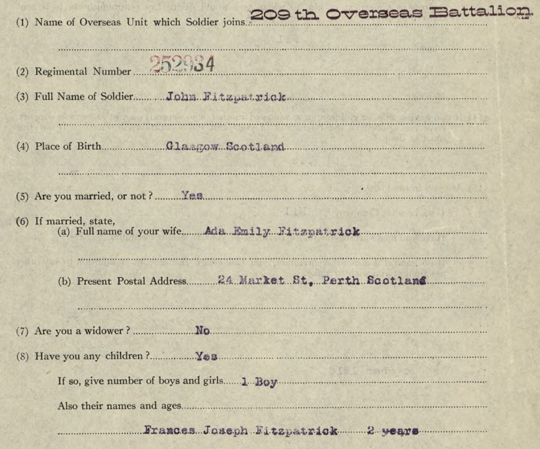
National – Library and Archives Canada (LAC) has launched a new database called Immigrants to Canada: Porters and Domestics 1899 – 1949. This database contains reference to some 8,600 individuals who came to Canada as porters or domestics (i.e. maids) between the years 1899 and 1949. It should be noted that many orphan girls from England were sent to Canada as domestic servants during this time period. If this fits the profile of one of your ancestors, then it may be worth checking out this database. Access is free. [Porters and Servants of Canada]
National – LAC has extended their database of naturalization records. The database now covers the years from 1915 to 1944, with work ongoing to extend the database to 1951. The database can be searched by first name, last name and country of origin. Access is free. [Canada Naturalization Records]
B.C. – FamilySearch.org has indexed some 318,000 death registrations from the province of British Columbia. These records cover the period from 1872 to 1986. B.C. started recording deaths in 1872, the year after the province joined Confederacy. Please note Chinese were excluded from the death registration until 1897 and aboriginals were excluded from registration until 1916 (with the exception of one brief period after 1897). Also note that in many circumstances, there were long delays between the date of death and the registration of the death given how isolated some communities were from the nearest government office.
A typical death record (see below) lists the name of the deceased, gender, date of death, where the person was born and cause of death. The collection can be searched by first and last name. Access is free. [B.C. Death Registrations]

National – Ancestry.ca has put online a collection of World War II service files of war dead. These are essentially files on soldiers that died during the war years. In total, there are about 44,000 WWII war dead files, of which Ancestry has put some 29,000 online. Service files such as these often contain multiple documents on each soldier, such as details on the soldier’s enlistment and service record. The collection can be searched by first and last name. Access is by subscription. [Canada World War II War Dead Soldier Service Files]
2015 January to June
National – The website Canadiana.ca has achieved the important milestone of processing some 21 million pages of Canadian historic records. This website chronicles the institutions and people that shaped Canadian history from the 1600s to the mid-1990s.
The non-profit organization behind the website is Canadiana.org. It was originally founded in 1978 to preserve Canada’s print heritage. There are 11 major collections on the website, including one specifically devoted to genealogy and local history and one devoted to the War of 1812. The website can be searched by keyword, collection and date range. Access is free. [Canadiana.ca]

National – Library and Archives Canada (LAC) is making good progress on digitizing their collection of First War military personnel records. Formally known as the Canadian Expeditionary Force Personnel Service Files, these records are being digitized systematically by box number, which roughly corresponds to alphabetical order. So far, LAC has digitized about one quarter of the boxes from A up to the surname Gilbert.
The pace of digitization is much faster than the original rate (as we discussed below last December) thanks in part to renewed emphasis from the new management at LAC. At the current run rate, all the records should be digitized and put online by the end of 2016. Access is free. [Canada WWI Military Records]
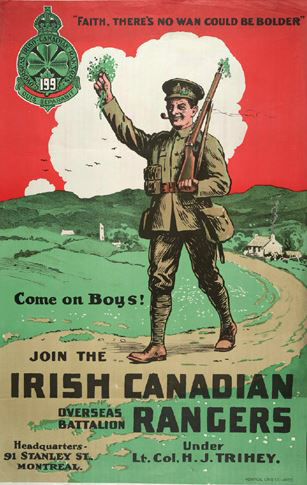
Newfoundland – FamilySearch.org has created a new record collection of Newfoundland vital statics. These are church records of baptisms, marriages and some burials. There are some 192,000 records in the collection, which spans the years from 1753 to 1893. This collection can be searched by first name and last name. Access is free. [Early Newfoundland Vital Records]
Ontario – The Ottawa Museums and Archives has started the process of creating a virtual online collection. The collection comes from several regional museums and the city archives. Items in the collection range from photographs to maps to letters to historic artifacts. The first batch of 34,000 records has already gone online. Hopefully, the entire collection will one day go online, which consists of some 3 million photographs alone. Search is by keyword. Access is free. [Ottawa Digital Archives]
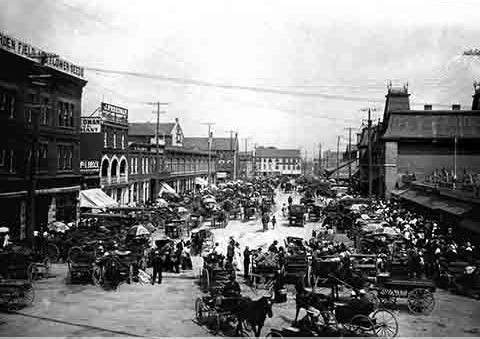
Ontario – FamilySearch.org has indexed an additional 246,000 records from their existing collection of Ontario marriages. This collection spans the years from 1869 to 1927. Although some jurisdictions in Ontario began recording marriages as early as 1801, province-wide registration did not begin until 1 July 1869. Also note that in the 1800s, people who lived near the US border sometimes chose to get married in the United States where marriage requirements could be less strict than in Canada. This collection can be searched by first name and last name. Access is free. [Historic Ontario Marriage Records]
Ontario – The Archives of Ontario has digitized and put online some 4,100 patent plans for the province. These are basically Crown land records. You can start your search by typing in the name of a township or town. Access is free. [Ontario Patent Plans]
Newfoundland – FamilySearch.org has put online browsable image collections of the Newfoundland 1921, 1935 and 1945 censuses. The images are organized by district. A typical record (using the 1935 census as an example) lists the name of the person, age, place of birth, gender, marital status, relationship to the head of the household, place of birth of mother and father, religion and occupation. At the time of these three censuses, Newfoundland was not part of Canada. Access to these collections is free. [Newfoundland 1921 Census] [Newfoundland 1935 Census] [Newfoundland 1945 Census]
Ontario – It looks like Library and Archives Canada (LAC) is accelerating the pace at which new records come online. This week, LAC has put online 152 historic city directories for the cities of Hamilton (1853 to 1895), Kingston (1865 to 1906) and London (1875 to 1899) and farm directories for most of the counties in southwestern Ontario (1864 to 1898). At GenealogyInTime Magazine, we know a fair bit about these records because we have a substantial personal collection of these books.
Farm directories in particular require some explanation. A sample image from an Ontario farm directory is shown below. Ontario is one of the few jurisdictions in the world that had this type of directory, thanks to the Union Publishing Company. They are a great way to track your rural Ontario ancestors during the 1850 to 1900 time period.
For these farm directories, in the countryside it lists the name of each farmer and the location of their farm (by concession and lot number). It also listed whether the farmer owned the land (f=freehold) or rented (t=tenant). It also usually lists the nearest post office for each farmer. This gives you a rough idea of the nearest village in case you are not familiar with the concession/lot system in the area.
For residents of towns and villages in the region, it lists each business person and trades person in the village plus their occupation/trade. Farmers who had retired to the villages were usually not listed.
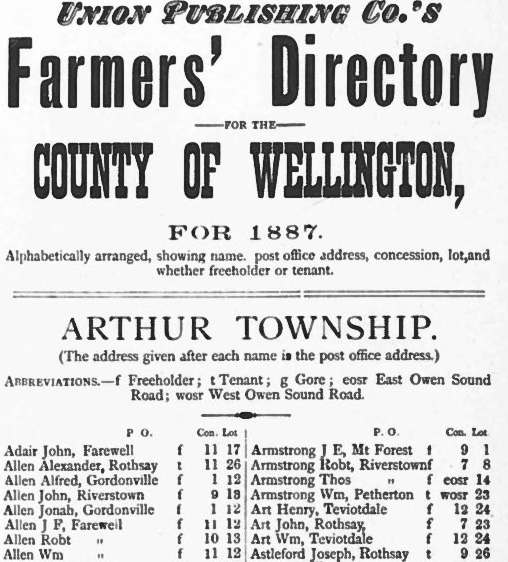
For the city directories of Hamilton, Kingston and London, most directories list the name, occupation and street address of each household. The earliest directories tended to list only businesses and trades people since these people were the primary audiences for these directories. The later directories were more inclusive.
If you start to see occupations such as labourer or retired or widow listed then you know the directory was fairly inclusive. Some names in early Ontario directories are bolded. These are thought to be businesses and business people that paid to be listed in the directory, nothing more.
With these new additions, LAC has more than doubled the number of historic city directories that they have put online. Access is free. [Canada City Directories]
City directories usually abbreviated common first names, address identifiers such as street or road and occupations in an attempt to cram more names onto a single page. Often these abbreviations are not very intuitive. We have some useful resources that can help you interpret city directory listings, such as a List of First Name Abbreviations, City Directory Abbreviations and a List of Occupation Abbreviations.
2014 July to December
National – Library and Archives Canada (LAC) has begun the process of digitizing the personnel service files of some 640,000 Canadians who served in the army during the First World War. Known officially as the Canadian Expeditionary Force [CEF] (since it was under the control of the British), a total of 424,589 Canadian soldiers served in Europe during the war. The initial contingent of 25,000 soldiers was sent overseas soon after the declaration of war in August 1914. By September 1915, the CEF had grown to the 1st and 2nd Canadian Divisions and the Canadian Cavalry Brigade. The CEF continued to grow until the end of the war in November 1918.
The service files in this collection contain up to three dozen different kinds of forms. It includes such things as enlistment records (attestation papers are already online), training records, medical and dental history, hospitalizations, disciplines (if any), pay records, medal entitlements and discharge papers or notifications of death. It also lists what regiment the soldier was located in, but not necessarily where the regiment fought (for that, it is necessary to consult the unit war diaries).
In total, there are some 32 million pages of records to be digitized from 640,000 personnel files. This means the average file per soldier is some 50 pages of records, making this a considerable resource. The first 76,000 files have already been digitized and put online. Regular uploads of about 5,000 new files are expected every two weeks. At the current run rate, this means it will take about 4.3 years for all the files to go online (or unfortunately about as long as it actually took to fight the First World War).
The digitized records are searchable by name, regiment and rank. Access is free. [Canada World War I Army Personnel Files]
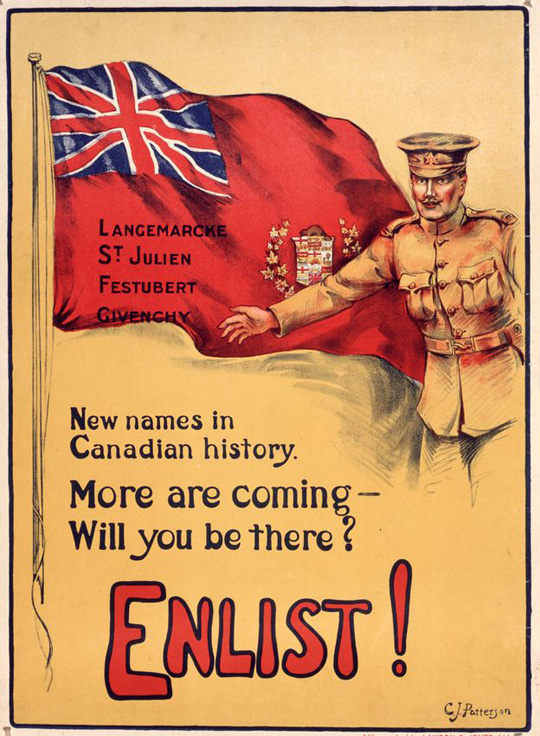
National – The Canada Genweb website celebrates 10 years this month. Congratulations! The website has indexed some 1 million names. It also has more than 600,000 photographs and provides a directory to 20,000 known cemeteries in Canada. It is a great resource for anyone with Canadian ancestors. Access is free. [Canada Genweb]
Nova Scotia – FamilySearch.org has put online a new image collection of Nova Scotia birth records. The first tranche of some 29,000 images dates from 1864 to 1877. These are the registration of births, not birth certificates. A typical birth register lists the following information: name of the child; gender; date and place of birth; father’s name; occupation; dwelling place (residence); mother’s maiden name; when and where the parents were married, and the name of an informant to the birth. Below is an image of a typical page from the birth register. This collection is organized by county and then by year. Access is free. [Historic Nova Scotia Birth Registers]

National – The website Canadiana has put online the militia lists of each unit of the Canadian Expeditionary Force as of August 1914 (the beginning of World War I). Each record lists the name of each member of the unit, rank, country of birth and date and place of enlistment. Some records also list next of kin and address.
Canada was unprepared at the start of World War I. It had only 3,100 men under arms. As volunteers were quickly recruited and organized in Canada, members of the Canadian Expeditionary Force were sent to Europe to help reinforce these newly formed units. Therefore, when looking for ancestors in this collection, be aware that they most likely left Canada under one unit and then were reassigned to a different unit as soon as they arrived in Britain. This collection can be searched by keyword (such as name) and date range. Access is free. [Canadian Expeditionary Force Records]
National – Library and Archives Canada (LAC) has made a major upgrade to their 1861 census of Canada collection. In particular, they have corrected over 133,000 entries. The largest correction involves records from Hamilton, Kingston, London, Ottawa and Toronto. These records were previously miscategorised. Several other major corrections to the database have also been made, primarily involving missing records and misplaced images. If you had previously tried to search this database, you should give serious consideration to rerunning your searches.
The 1861 Canada census covered Ontario, Quebec and the Maritimes. The database can be searched by last name, first name, age, province and keyword. Access to this collection is free. [Canada 1861 Census Records]

National – FamilySearch.org has indexed 3.4 million records from the Canada 1911 census. This is close to half the 7.2 million individuals who were enumerated in 1911. A typical record from the Canada 1911 census lists the name of each person in the household, place of residence, relationship to the head of the household, marital status, date and place of birth, year of immigration, year of naturalization, nationality, religion and occupation. In many instances, the image of the original census record is not available (see the Library and Archives Canada website to view the original images from the 1911 census). Access is free. [Canada 1911 Census Records]
2014 January to June
Ontario – FamilySearch has added some 334,000 indexed records to their collection of Ontario birth records. This collection spans the years from 1869 to 1912. Effective 1 July 1869, the province of Ontario began to register births, marriages and deaths. Each county kept a district registrar, which was then sent to the provincial registrar. The birth records in the FamilySearch collection can be searched by name, gender, year and place of birth. Please note that if you search by year, not all the records in the collection have the year listed. Access is free. [Historic Ontario Birth Records]
Quebec – The Drouin Institute has put online 1.3 million free Quebec obituaries dating from 1999 to the present. These obituaries have been collected from 250 different internet sources. The records can be searched by name and date of death. Access is free. [Recent Quebec Obituaries]
2013 October to December
National – FamilySearch.org has added an additional 2.2 million records of passenger lists from various Canadian ports. This collection spans the years from 1881 to 1922. Access is free. [Canada Passenger Records]
Ontario – FamilySearch.org has indexed an additional 354,000 Ontario marriage records. This collection spans the years from 1869 to 1927 and can be searched by name. Access is free. [Ontario Marriage Records]
National – FamilySearch.org has indexed some 1.7million records of Canada passenger lists. These lists can be searched by name, making it easy to find ancestors. The list of ports covered is extensive: Quebec City (1900 to 1921); Halifax (1881 to 1922); Saint John (1900 to 1912); North Sydney (1906 to 1912); Vancouver (1905 to 1912) and Victoria (1905 to 1912). Also included are records from New York (1906 to 1912) and other Eastern US ports that list the names of passengers who intended to proceed directly to Canada.
Each record lists the full name of the individual, the date of arrival, port of arrival, place of birth and the name of the ship. Some of the original records contain additional information, as shown in the image below. Access to this collection is free. [Canada Passenger Lists]
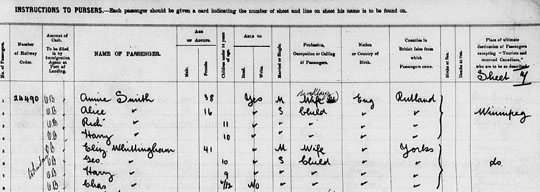
2013 July to September
Quebec – Ancestry has launched a collection of passenger list records from the St. Lawrence Steamboat Company. This collection consists of some 187,000 records and spans the years from 1819 to 1838. The St. Lawrence Steamboat Company was started by John Molson several years after the success of his brewing enterprise. The shipping company carried passengers and freight along the St. Lawrence River between Quebec City and Montreal. This collection can be searched by name. A typical record lists the name of the passenger, date and port of embarkation and destination. Access is by subscription. [St. Lawrence Passenger Records]
National – Library and Archives Canada (LAC) has formally announced some details regarding their partnership with Canadiana.org. Their 10-year agreement will involve the digitization of about 60 million images, with transcribing and indexing of personal, administrative and governmental documents as well as land grants, war diaries and photographs. [LAC and Canadiana.org Digitization Project]
National – Library and Archives Canada (LAC) has finally announced the release of the Canada 1921 census. It turns out, however, by their own admission that LAC lacks the capability and resources to host the census images on their own website. Instead, LAC signed a contract with Ancestry that allows Ancestry.ca exclusive right to host the images. The images will be available for free, but only to Canadian residents and only on the Ancestry.ca website.
Ancestry is currently indexing the images and a name index is expected to be available within 2 to 3 months. Anyone wanting to search the Canada 1921 census by name will require an Ancestry subscription.
The LAC website contains more details on the contract between LAC and Ancestry, which can be accessed here. Apparently, the contract was signed over five years ago. It gives Ancestry exclusive commercial access to the digitized images for a period of five years. Three years after Ancestry publishes an index to the Canada 1921 census images on its website, LAC will get a copy to publish on its own website.
There is clearly some controversy surrounding LAC’s approach to releasing the Canada 1921 census. Blogger John Reid had to do an Access to Information Request to the Canadian government to get some answers. You can read his excellent summary on his blog Anglo-Celtic Connections.
We have one comment. At GenealogyInTime Magazine, we track and monitor the release of all the major genealogical record sets from around the world (which can be found in our list of new genealogy records). This is something we have been doing for almost five years. In those five years, we are not aware of any other large government archive anywhere in the world that gives its most important genealogical records away to a for-profit company on such generous terms.
One of the most important fields in the Canada 1921 census is the one that lists the country of origin of the mother and father of the person being enumerated. This was new to the 1921 census and can be very valuable information for anyone tracing their ancestors.

Since the 1921 census currently cannot be searched by name, one way to get started is to search the free Canada 1911 census (which is indexed by name) to find the census district of your ancestors. Use this information as a starting point in searching the images from the Canada 1921 census.
Ancestry makes you jump through a couple of hoops before being able to access the free 1921 census images. First, even though the images are supposed to be available for free, Ancestry.ca has chosen to bury the link on their website. Use the link below to find it. Also, it is necessary to provide a name and valid email address to Ancestry before accessing the images for anyone who does not have a current Ancestry subscription. [Canada 1921 Census]
Ontario/Quebec – Library and Archives Canada (LAC) has been busy recently putting up every census except the Canada 1921 census (which was expected to be released on 1 June 2013). This week, LAC has released the 1842 census of Canada West (modern-day Ontario) and the 1842 census of Canada East (modern-day Quebec). These censuses contain somewhat limited information for ancestral research: name of the head of the household, occupation and number of residents in the household are the main fields of interest to genealogists.
The census also broke out the number of members of the household by age category, the country of origin (Canada, England, Scotland, Ireland and the US), the religion, the amount of land owned by the household and the agricultural production. The purpose of the census was to determine the distribution of parliamentary ridings, more detailed information on each member of the household was not required, and thus not collected. These databases can be searched by name. Access is free. [1842 Canada West Census] [1842 Canada East Census]
Manitoba – Library and Archives Canada (LAC) has put online the 1870 census of Manitoba. This census was taken shortly after Manitoba joined Confederation. It consists of some 12,200 individuals who lived in the region at that time, including aboriginals. Information listed in the census includes name, age, marital status, place of birth, religion, race and name of the father. All individuals in the region are listed (not just the head of the household). This census was taken one year before the first national census of Canada in 1871 and it was the first broad census in Manitoba (previous censuses of Manitoba tended to focus on the area around the Red River settlement). The census can be searched by name and keyword. Access is free. [Manitoba 1870 census]
2013 April to June
Quebec – Library and Archives Canada (LAC) has put online the 1825 census of Lower Canada. Lower Canada is modern-day Quebec and this census covers some 74,000 households. This early census only lists the head of each household, their occupation and the number of family members. The database can be searched by family name, first name and keyword. Remember, only the head of the household is listed by name. Access is free. [1825 Lower Canada Census]
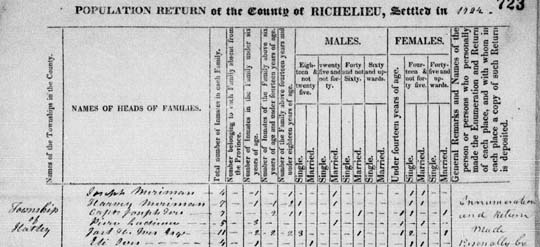
Eastern Canada – Ancestry has added a number of early Canadian military records to its collections. The largest addition consists of some 750,000 records of British Army and Canadian Militia Muster Rolls from 1795 to 1850. These are records of British career soldiers and local militias in Canada during the early 1800s. Most of the records are muster rolls and pay lists. The data recorded includes name, enlistment date, movement and discharge date. The database can be searched by name. Access is by subscription. [Early Canadian Militia Records]
National – The release of the 1921 Canada census has been delayed. Taken on 1 June 1921, the census technically should have been released on 1 June 2013 to all Canadians (92 years later according to Canadian law). Instead, Library and Archives Canada (LAC) has announced the census will be released “in the next few weeks”. No other details have been provided by LAC.
The 1921 Canada census consists of 197,500 images of approximately 8.8 million people (8,788,483 individuals to be exact). Below is an image of the sample census form used by the enumerators.

The questions asked in this census includes the name of each person in the household, address, whether the house was owned or rented, monthly rent (if applicable), building material of home (wood, stone, etc.), number of rooms in house occupied by the family, relationship of each person to head of household, sex, marital status, age, place of birth of the person and each of their parents (if in Canada it lists the province, if foreign it lists the country), year immigrated to Canada, year of naturalization, nationality, race or tribal origin, can the person speak English, can the person speak French, can the person speak other languages, religion, can the person read and write, occupation, employer, type of product made by employer, annual salary and details on unemployment (if applicable).
For those super-keen genealogists, attached is a link to the instruction book used by the enumerators with detailed instructions on how each column of the census form was to be completed. [Canada 1921 Census Instructions]
If you want to track the latest news of when the census will actually be released, you can follow along with the LAC Blog [1921 Canada Census News]
National – Library and Archives Canada (LAC) has released an updated version of the 1901 census of Canada. This new version includes revisions to the database that were sent in by users over the last several months as well as revised district and sub-district information.
The 1901 Canada census was the fourth general census of Canada (1871, 1881, 1891 and then 1901). It covered the provinces and territories then in existence: B.C., Manitoba, Ontario, Quebec, New Brunswick, Nova Scotia, Prince Edward Island and the Northwest Territories (current day Alberta, Saskatchewan, Yukon, Nunavut, etc.). The database can be searched by province, name and keyword. Access is free. [Canada 1901 Census]
National – Library and Archives Canada (LAC) has released a new version of the 1871 Canadian census. This was the first general census of Canada. It covered the four provinces that were then part of Confederation: Ontario, Quebec, New Brunswick and Nova Scotia. This new version includes many corrections sent in by users as well as revised/improved district and sub-district information. The collection can be searched by name, age, province and keyword. Access is free. [Canada 1871 Census]
Ontario – The Ontario Name Index (TONI) is approaching 2 million records. Approximately 100,000 names are being added to the index each month and the project is now over 60% complete. The Ontario Genealogical Society is looking for volunteers to help further the project. Please follow the link for further information. [TONI Volunteers]
2013 January to March
World – ProQuest has announced they will now become a global distributor for NewspaperArchive. ProQuest is the ancestry database used by many public libraries. NewspaperArchive is the largest (130 million records) online newspaper archive. You might want to check with your local library to see if they subscribe to ProQuest. If they do, then this will be a convenient and free way to access Newspaper Archive. Newspaper Archive has newspapers from around the world, with a focus on historic newspapers from Canada and the US. The link is to the press release, which lists some of the major newspapers in the Newspaper Archive collection. [Proquest]
National – Library and Archives Canada (LAC) has released an indexed version of the Canada 1911 census. Previously, this census was only available on the website in image format. Now this census can be easily searched by family name, first name, age and province. This is a major new record set for anyone looking for their Canadian ancestors (and for anyone who is waiting for it, the Canada 1921 census will be released on 1 June 2013). Access to the Canada 1911 census is free. [Canada 1911 Census]
New Brunswick – The New Brunswick GenWeb project has put online information on an additional 55 cemeteries in the province and provided updates on a further 16 cemeteries. The records can be searched by name and by region. Access is free. [New Brunswick Cemetery Records]
National – Library and Archives Canada has created a special database for anyone tracing ancestors who arrived from China. The database has some 100,000 records and spans the years from 1885 to 1949. Access is free. [Chinese Immigration Records]
Prairies – Library and Archives Canada (LAC) has just released a new version of the 1906 Census of the Northwest Provinces. This census covers the three prairie provinces of Alberta, Saskatchewan and Manitoba. This census has been available to search before, but it was limited to image searches by geographic region. The new database can now be searched by name, age, and keyword. We have found this to be a massive improvement. One ancestor that we had difficulty tracking down, we were able to locate in about 30 seconds with the new and improved database. It is definitely worth checking out. Access is free. [1906 Census of Alberta, Saskatchewan and Manitoba]
Ontario – The Ontario Genealogical Society (OGS) is looking for volunteers to help transcribe documents for The Ontario Name Index (TONI). The documents that require transcription include everything from diaries to letters to obituary notices to old newspapers, all from the province of Ontario. Transcribers work from the comfort of their home and the society will send you pdfs of the documents that require transcription. Complete details can be found on the OGS website. [The Ontario Name Index]
2012 October to December
Quebec – FamilySearch.org has put online an additional 750,000 images of Quebec notary records. The entire collection consists of some 3.6 million images and spans the period from 1800 to 1900. The records come from the Quebec Archives. Access is free. [Historic Quebec Notary Records]
Ontario – The US Data Repository website has added a new section called Great Lakes Maritime History. Dedicated to the genealogy history of the Great Lakes, it covers both US states and Canadian provinces that surround the Great Lakes. At the moment, the records listed include biographies, 1930 census of merchant seamen, a list of shipwrecks, and a list of US and Canadian lighthouses. The US Data Repository is part of the USGenNet system. Access is free. [Great Lakes Maritime History]
Saskatchewan – FamilySearch.org has created a new browsable image collection of Catholic Church records from Saskatchewan. The 286,000 images in the collection span the years from 1846 to 1957. The images include baptisms, confirmations, marriages and burials. The images are organized by town/city and then by parish. Many of the records are written in French. Access is free. [Saskatchewan Catholic Church Records]
BC – FamilySearch.org has put online a new collection of some 540,000 images of crown land grants for the province of British Columbia (1869 to 1930) and a collection of some 285,000 images of land records for the province (1885 to 1949). These image collections have indexes that should be consulted first. Access to both collections is free. [Historic BC Land Grant Records] [Historic BC Land Records]
BC – FamilySearch.org also added some 783,000 images of probate records (wills, estate files, etc.) from the province of British Columbia. This collection spans the years 1859 to 1949 and covers the southern part of the province. Please note these records are organized by court district. For example the New Westminster records cover most of the Fraser Valley (excluding Vancouver). Indexes exist for the probate records from Victoria and Vancouver. Access is free. [Historic BC Estate Records]
Ontario – FamilySearch.org has created a new indexed collection of Ontario birth records. The new collection currently has some 82,000 records and covers the years from 1869 to 1912. Ontario began officially registering births on 1 July 1869 (along with marriages and deaths). Access is free. [Historic Ontario Birth Records]
BC – The Royal BC Museum/Archives has uploaded approximately 700,000 scanned and indexed historical records of births, marriages and deaths in British Columbia. The museum is making these records and the associated images of the original documents freely available as part of the province’s open government policy.
In B.C, vital records can be released 20 years after a death, 75 years after a marriage and 120 years after a birth. Official government vital records began in the province in 1872. Birth records list name, date and place of birth, parents’ names and the mother’s maiden name. Marriage records list the name, age, place of birth and marital status of the bride and groom as well as the date and place of the ceremony, names of the parents, names of witnesses and the person who performed the wedding ceremony. Death records list the name and date of birth of the deceased as well as the date and place of death and the cause of death.
Not all the images of the records are immediately online. The balance consisting of some 300,000 additional images are expected to be added by the end of 2012. This would include overseas deaths in World War II, death records from 1985 to 1991 and marriages from 1933 to 1936. As well, any available pre-1872 records will be added by the end of 2012. This will bring the entire collection to some 1 million records. This is a first for Canada and great news for anyone with ancestors from British Columbia. Access is free. [Free Historic B.C. Birth, Marriage and Death Records]
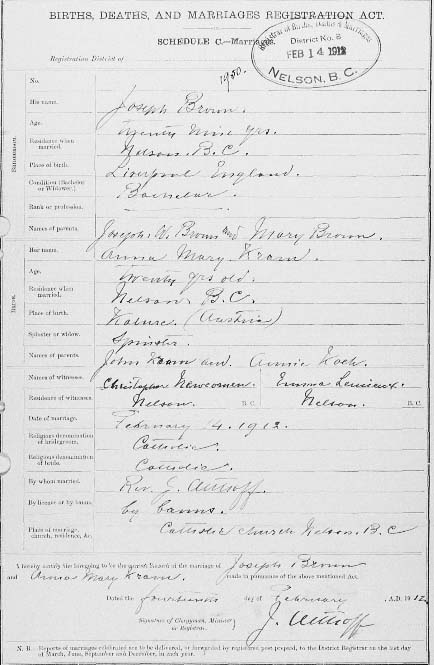
National – McGill University has created a collection know as McGill Remembers. It consists of lists of faculty, staff, students and alumni that participated in World War II. The collection also consists of newspaper clippings and correspondence related to the war effort by the university. In total, there are some 6,600 names, more than 3,000 files and about 700 photographs in the collection. Access is free. [McGill University World War II Records]
PEI – The University of Prince Edward Island has digitized The Island magazine from 1976 to 2007. The Island often contained historic articles about PEI. This collection can be searched by keyword. Access is free. [The Island Magazine]
National – Ancestry.ca has added a couple of new collections of Canadian military records to its website ahead of Remembrance Day on 11 November. These include nominal rolls and pay lists for volunteer militia (1857 to 1922, some 1.6 million records) and military honours and awards citation cards (1900 to 1961, some 68,000 records). Also added were an additional 71,000 records from the war graves registers (1914 to 1948) that discuss the circumstances of casualty. Access is by subscription. [Canada Historic Militia Rolls] [Canada Military Awards] [Canada War Graves Registers]
Ontario – ProQuest has added 165 years of the Globe and Mail newspaper to its newspaper collection. The Globe and Mail originally launched as The Globe newspaper in 1844 in Toronto. Since then, it has grown to become the “newspaper of record” for much of Canada. ProQuest has digitized the entire newspaper from 1844 to 2009, some 1.5 million pages in total. Early versions of the newspaper are full of birth and death notices from the greater Toronto area. This is an excellent resource to check if you had ancestors from the region during the 1840 to 1870 time period when records are hard to find. ProQuest now has some 30 million pages in its historic newspaper collection that are accessible online. The ProQuest online newspaper collection is usually accessible only through local libraries. They do not sell individual subscriptions. [ProQuest]
PEI – FamilySearch has indexed some 92,000 records of Prince Edward Island baptisms. These are records transcribed from other sources (basically a collection of baptisms put on index cards) and span the years 1721 to 1885. Most of the records date from 1830 onwards. Access is free. [PEI Baptism Records]
Ontario – The Ontario Genealogical Society’s Ontario Name Index now has 1 million names in the database. The purpose of The Ontario Name Index (TONI) is to provide a single index of Ontario names, with pointers to where additional information can be found on any given individual in the database. This database has been created by the dedicated effort of a group of volunteers. If you would like to participate, you can contact the coordinator Mike More at toni@ogs.on.ca Access to the database is free although there may be some cost to buy the underlying record. [The Ontario Name Index]
National – Ancestry.ca has put online a major collection of Canadian voter lists. These are more generally called electoral rolls, as discussed in the article Searching Electoral Rolls for Ancestors. The Canadian voter lists cover the period from 1935 to 1980, with each list organized by voting district (within each province) and then by polling station number and finally by address. The lists are spaced roughly 3 years apart from each other (although the earlier lists from 1935 to 1950 are spaced roughly 5 years apart). This collection comes from Library and Archives Canada, which surprisingly does not have their own collection on their own website.
A typical record in this collection lists the name of the eligible voter, home address and occupation. By 1935 (the start of this collection), women were eligible to vote in national elections in Canada and the voting age was 21. In 1970, the voting age was dropped to 18 and it was necessary to be a Canadian citizen to vote in national elections.
A couple of things to note about this collection:
• Ancestry lists about 89 million names in the collection, but the number of eligible voters during this period was about 120 million, meaning this collection is a bit less than 75% complete.
• These records have not been transcribed. Instead Optical Character Recognition (OCR) software was used to try to read the records from the original microfilm. In many cases (especially with the older lists from 1935 to 1949), the microfilm text was too smudged for the OCR software to be able to read it. This results in unexpected gaps in the data for the collection (based on whether or not a random roll of microfilm was OCR-readable).
• It is interesting to note that Ancestry has been able to post government voter lists online from as recently as 1980 without (presumably) violating Canada’s privacy laws. Somebody needs to explain to us how they managed to do this.
Access to these voter lists is by subscription. They can be searched by name. [Historic Canada Voter Lists]
2012 July to September
National – GenealogyInTime Magazine has added 400 million new records to their two free search engines. The Genealogy Search Engine (which covers ancestral records) now searches an additional 100 million more records, while the Family Tree Search Engine (which covers genealogy forums and online family trees) searches approximately 300 million more records.
In total, the two search engines now cover 5.7 billion records across more than 1,000 different websites (split between the Genealogy Search Engine covering 1.9 billion records and the Family Tree Search Engine covering 3.8 billion records – there is no overlap of records between the two search engines).
GenealogyInTime Magazine now gets over 40,000 queries per month for the two search engines. This makes them one of the most popular alternatives to the FamilySearch website for people wanting to look for free ancestral records. Significant holdings exist for the United States, Canada, England/Wales, Scotland, Ireland, Continental Europe, Australia and New Zealand with minor holdings for the Caribbean, South America and South Africa.
Some of the highlights of the latest addition to the Genealogy Search Engine include:
• 55 million new records for the United States and 6 million new records for Canada. These are primarily ancestral records held in digital archives of public libraries and universities across North America. Many of these new records are historic photographs.
• 23 million new records for England, Ireland and Scotland. These are primarily twentieth century obituaries.
• 14 million new records for Europe. These are primarily birth/marriage/death records from Central and Eastern Europe.
• 2 million more ship passenger records.
In this latest release, the search routines for both search engines have also been strengthened to provide better results. In addition, the number of returned records for a search query has been increased from 8 pages to 10 pages. Finally, results are delivered even faster than before.
Access to both search engines is free and the underlying records are also free. [Genealogy Search Engine] [Family Tree Search Engine] GenealogyInTime Magazine also has a number of genealogy articles to help you become better at online genealogy searches.
GenealogyInTime Magazine is the world’s most popular online genealogy magazine. It is also now the fifth largest free genealogy website in the world (according to Alexa, the internet traffic people, the largest free genealogy websites in order are FamilySearch, Find A Grave, Geni, GeneaNet and GenealogyInTime Magazine).
National – Ancestry.ca has updated its collection of 4.8 million records of border crossings between Canada and the United States from 1895 to 1954. This database generally includes the following information: name, age, date and place of birth, gender, ethnicity/nationality, names of any travelling companions and names of a relative or friend at the destination. These records were collected by the US Immigration Service and so will be primarily of interest for people wanting to trace ancestors who crossed from Canada into the United States. Also, please note that many crossings at the Canada/US border were not fully staffed until the early 1930s and it was perfectly possible (and legal) before this time for someone to cross into the United States without making a declaration. Access is by subscription. [Historic US Border Crossing Records]
Ontario – The Quinte branch of the Ontario Genealogical Society has added an additional 105,000 names to its database of cemetery transcriptions, baptism records, newspaper indexes and genealogies. The database now contains some 1.1 million names. The Quinte area covers the counties of Hastings, Prince Edward and parts of Northumberland and is located on the northern shore of Lake Ontario. The region was one of the first areas settled by United Empire Loyalists in 1784. The database provides an index to paper records. There is a modest fee to order the paper records. [Quinte Genealogy Records]
Ontario – FamilySeach.org has indexed some 246,000 records from its collection of Ontario marriage certificates (see image below). A typical record lists the full name of the groom, full name of the bride (including maiden name), occupation of the groom, age of bride and groom, name of mother and father of the bride and groom and the date and place of marriage. Also, something often not seen on marriage certificates, the place of birth of both the bride and groom. These records come from the Archives of Ontario. Access is free. [Historic Ontario Marriages]
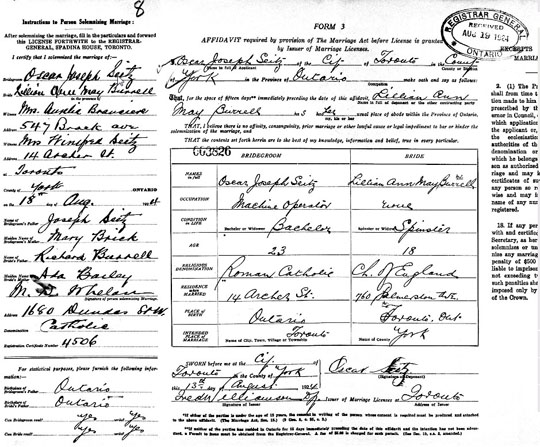
Nova Scotia – The Public Archives of Nova Scotia has put online two historic Nova Scotia newspapers: The Acadian Recorder (1813 to 1853) and the Liverpool Transcript (1854 to 1867), from the town of Liverpool. Liverpool in particular had an outsize part in the early history of New England and the Caribbean. Many of the original inhabitants of Liverpool migrated from Connecticut in 1762. The town subsequently became the home and base of operations for many well-known pirates who operated up and down the New England coast and into the Caribbean. The town and surrounding area was repeatedly attacked by business interests and privateers from New England trying to route out the pirates. Oak Island (rumored to be the home of Captain Kidd’s hidden treasure) is just off the coast from Liverpool. Access to these newspapers is free. The newspapers are not indexed and must be read by date. Anyone looking for death notices in these papers should note that death notices can be easily spotted by the thick black border around them. [Historic Nova Scotia Newspapers]
National – Library and Archives Canada (LAC) has launched its own YouTube channel. The first introductory video below provides a good brief description of you what you need to do if you want to access the LAC archives in person. The second short video describes the online search process. Well worth watching both videos even if you are familiar with LAC. [Library and Archives Canada YouTube Channel]
National – A new website has launched on the War of 1812. This website tells the story from the Canadian perspective. The website includes articles, news, videos and links to various books on the subject. Access is free. [War of 1812]
2012 April to June
New Brunswick – FamilySearch.org has created a browsable image collection of New Brunswick marriage registrations from 1887 to 1950. In January 1888 the province instituted compulsory registration for all vital statistics (including marriages), so this collection should be fairly complete. The early records (1887 to 1919) are arranged alphabetically by year and by the surname of the groom, making it easy to search.
The registration forms ask the bride and groom such questions as full name, occupation, age, religious denomination, place of birth, name of mother and father, maiden name of mother, place of birth of father and whether the person could read/write. It also lists the place and date of marriage, whether the marriage was done by license or banns, witnesses (with their address) and clergyman (with address). See sample image below. In total, there are some 260,000 images in this collection. Access is free. [New Brunswick Marriage Records 1887 to 1919] [New Brunswick Marriage Records 1920 to 1950]
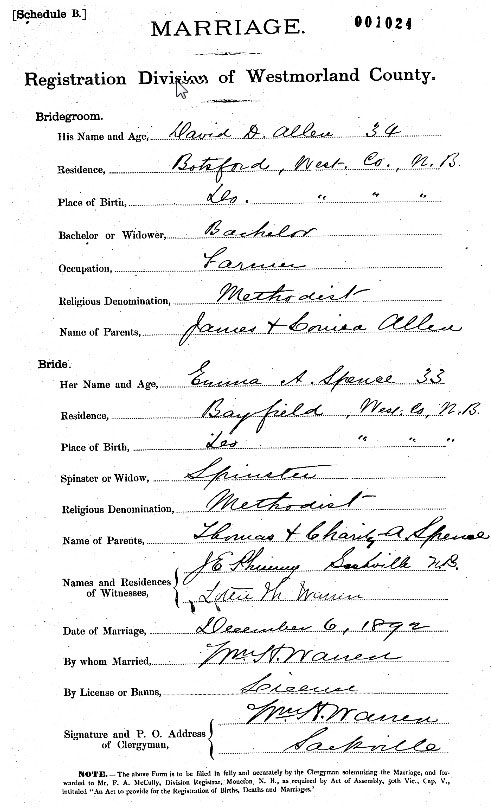
Ontario – The Niagara Peninsula branch of the Ontario Genealogical Society has created an index for all the funeral records from Morse & Sons Funeral Home in Niagara Falls, Ontario. The index contains some 18,000 names and covers the period from 1828 to 1960. The index can be searched by name and year. It is free to search the index, which provides the date of death, name of deceased, who paid for the funeral and the location of the handwritten record in the funeral book. There is a modest charge to see the underlying handwritten record. Morse & Sons was one of Canada’s first funeral homes and this collection spans an amazing 170 years. [Niagara Funeral Home Records]
Saskatchewan – FamilySearch has added about 62,000 additional images of various documents from the Provincial Archives of Saskatchewan. This includes such items as homestead lists, voter lists, pioneer questionnaires, biographies, military records, teacher registries, municipal records, township records and Henderson Directories (basically a city directory of homes and businesses). The total collection now contains some 415,000 images and spans the years 1800 to 1900. Access is free. [Historic Saskatchewan Ancestral Records]
National – Library and Archives Canada (LAC) has put online an additional 73,000 images from the War of 1812. These records are actually three series. The first series deals with claims for 1812 losses from the Board of Claims (1813 to 1848). The second series is the Upper Canada (basically Ontario) militia returns, nominal rolls and paylists. The third series is the Lower Canada militia returns, nominal rolls and paylists. The entire LAC War of 1812 collection now consists of muster rolls, paylists, claims, medal lists, maps, paintings and claims from the war. Even if you think your ancestors were not in the war, they may have filed a claim for various things, such as damage to their property. The images are not searchable by keyword. Access, however, is free. [Canadian War of 1812 Claim Records] [Upper Canada Militia Records][Lower Canada Militia Records] [War of 1812 Miscellaneous Records]
National – The Canadian Museum of Civilization has put online a fascinating collection of Canadian mail order catalogues. The catalogues span the years from 1880 to 1975. If you are trying to date an old photograph by the type of hat or dress worn by the women in the image, or by the date of other artifacts in the image, then a collection of old catalogues can be a very valuable resource. Hats and dresses go in and out of fashion and (with a bit of practice) by cross-comparing cloths in an old photograph to the cloths in a catalogue you can reasonably narrow down the date range when an image was taken. Access to the catalogues is free. [Historic Mail Order Catalogues]
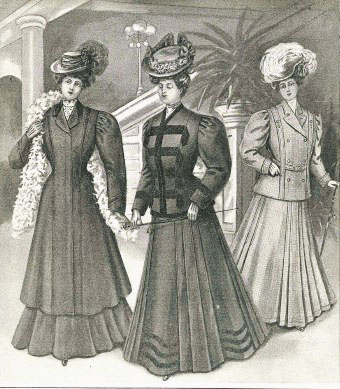
2012 January to March
National – Library and Archives Canada (LAC) has released a collection of some 121,000 images of new immigration records for people who passed into Canada from United States border posts between 1908 to 1918 and 1925 to 1935. These are browseable images. One thing to note is that there were many unmanned border posts between the two countries during this period. It is possible someone migrated from the United States to Canada without formally declaring themselves to the Canadian government during this time period. Nevertheless, it is definitely worth checking this collection. With this latest batch, LAC has released all the immigration records in its custody from 1865 to 1965. Access is free. [Historic Canada US Border Immigration Records]
Saskatchewan – FamilySearch.org has increased its collection of government records from Saskatchewan. This latest collection consists primarily of homestead records from 1908 and 1909. In total there are some 355,000 images in this collection. Access is free. [Saskatchewan Homestead Records]
Quebec – FamilySearch.org has added 92,000 records from the 1831 census of Lower Canada (modern day Quebec) and created a new collection composed of 47,000 records from the 1842 census of Lower Canada. Both record sets can be searched by first and last name. Access is free. [Lower Canada 1831 Census Records] [Lower Canada 1842 Census Records]
Nova Scotia – Ancestry.ca has updated its collection of Nova Scotia vital records. A total of 244,000 new Nova Scotia birth records from 1836 to 1910 have been added as well as 428,000 new Nova Scotia death records in the time periods 1864 to 1877 and 1890 to 1960. Access is by subscription. [Nova Scotia Birth and Death Records]
Ontario – Library and Archives Canada has made a major update to its Upper Canada Land Petitions database, which covers the years 1763 to 1865. More than 5,000 new records have been added as well as some 358,000 images. In total, some 82,000 people are listed in the database. Access is free. [Upper Canada Land Petitions]
BC – The British Columbia Archives has put together an excellent web page identifying how and where to track down vital records related to births, marriages and deaths in the province. If you are tracing ancestors in B.C., this is the place to start. [Tracing B.C. Ancestors]
Saskatchewan – FamilySearch.org has created a new image collection of probate estate files from Saskatchewan. The collection spans the years 1887 to 1931 and totals some 1.6 million images. These estate files are loose papers that relate to the settlement of estates and list such matters as provisions for heirs and distribution of funds, land and property. This collection was indexed in partnership with the Saskatchewan Genealogical Society. This collection can be searched by name. Access is free [Saskatchewan Historic Probate Records]
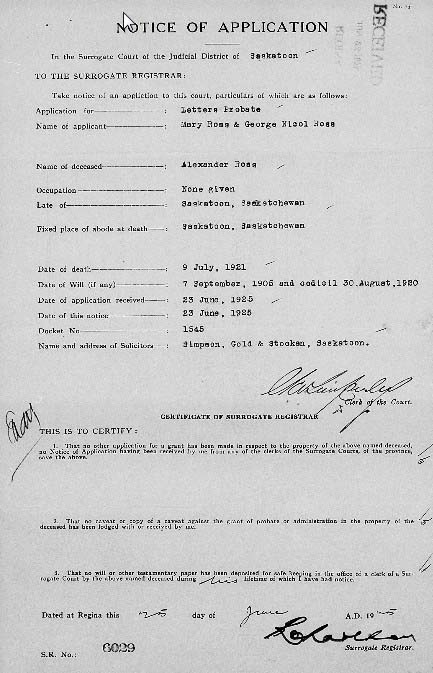
2011 October to December
National – Library and Archives Canada has digitized two important World War I collections: the Commonwealth War Graves Registers and the Circumstances of Death Registers. These images are not searchable by keyword, but are organized by microfilm number with each microfilm filed in name order. Therefore, searching these digitized microfilms is very similar to the experience of going to a reading room. This new online collection is definitely worth checking if you have a Canadian ancestor who died in the First World War. It will provide details on how your ancestor died (see image below). Access is free. [Canada World War I Soldier Deaths] [Canada World War I Commonwealth War Graves Register]
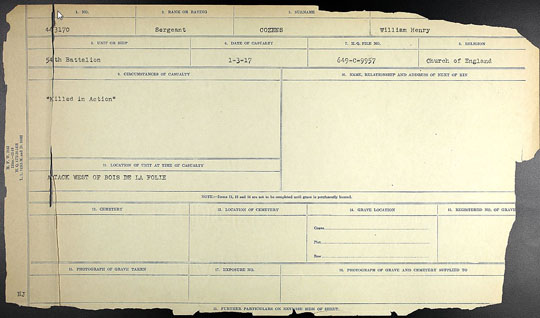
New Brunswick – FamilySearch has added an additional 88,000 images to its collection of New Brunswick county deed registry books. This collection now totals some 800,000 images and spans the years 1780 to 1941. The deeds are organized by county and each county has an index book that is organized alphabetically by date range. Access is free. [Historic New Brunswick Land Deeds]
BC – The University of British Columbia has put online a collection of historic small-town newspapers from across the province. The newspapers range from the Abbotsford Post to the Nelson Tribune and date from 1865 to 1924. This covers the early days of the province when the economy was primarily driven by mining, forestry and fishing. In total, some 24 newspapers spanning 45,000 pages are in the collection. The publications are fully text searchable and are free to access. Users can search by key word, date and newspaper title.
This collection is well set up for genealogists tracing their ancestors. Individual pages from the collection can be downloaded as jpg files and complete newspapers can be downloaded in pdf format. Most of these digitized newspapers come from the extensive newspaper collection held by the BC Archives. It is expected that more titles will be added in the future. [BC Newspaper Archive]
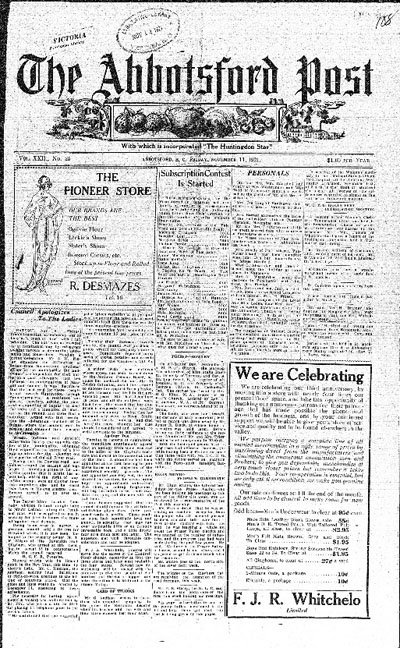
Commonwealth - Ancestry.co.uk has published details on the 880,000 soldiers who received Silver War Badges (SWB) in World War I. These were small, circular badges made of silver, with the king’s initials, a crown and the inscription ‘For King and Empire’ and ‘Services Rendered’ (see image below). They were granted to soldiers who had been honourably discharged from the war due to wounds or illness.
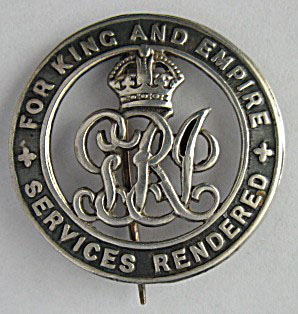
The SWB was intended to be worn with civilian cloths (it was forbidden to be worn on a military uniform). The SWB was given to discharged soldiers to prevent them being accosted by women with white feathers (a symbol of cowardice), which were presented to able-bodied men on the home front who were not wearing a uniform. This collection includes SWBs given to soldiers across the Commonwealth. A typical record lists name, rank, regiment number, unit, date of enlistment, date of discharge and reason for discharge. Many service records from World War I were lost. If you suspect this may have happened with your ancestor, then you should check this collection. Sometimes, the SWB record is the only record of military service that survived the Great War. Access is by subscription. [Silver War Badge Service Records]
National – Library and Archives Canada has launched a new database called Royal Canadian Navy Ledger Sheets. It provides access to records of individuals who served in the Canadian Navy from 1910 (when it was formed) to 1918. In total, about 16,800 people are listed. The database also has a list of those who enlisted between 1919 and 1941. A typical record lists the full name of the individual, service number, date and place of birth, occupation prior to joining the navy and a record reference number. The records can be searched by name or service number. The system supports wildcard searches. Access is free. [Canada World War I Navy Service Records]
National – Olive Tree Genealogy has reconstructed and put online the names of Poor Law immigrants who sailed to Canada between 1836 and 1871. Poor Law immigrants were poor people from workhouses in the UK. In 1833, the British government passed legislation that allowed these people to emigrate to Britain’s colonies (primarily Canada, Australia and New Zealand) under certain conditions. The ideal candidate was either a farm laborer or a domestic servant. The new Olive Tree collection lists immigrants on 23 ships who came to Canada under the program. Olive Tree Genealogy is a neat website run by Lorine McGinnis Schulze and it is well worth checking out for anyone tracing their Canadian ancestry. Access is free. [Poor Law Immigrants to Canada]
National – Google Map Maker is now available in Canada. Although not a genealogy record set per se, it is an excellent tool for tracking genealogy locations such as cemeteries, churches, etc. Google Map Maker is now available in both the United States and Canada (but not yet available in the UK, Ireland, Australia or New Zealand – see the complete listing of availability by country). If you are not familiar with Google Map Maker, watch the video below to get started.
National – Library and Archives Canada has released a new version of their database Home Children (1869-1930). An additional 20,000 names were added to the database by extracting them from various passenger lists covering the period 1925 to 1932. A typical record lists the name and age of the child, ship, date of departure, date of arrival. The sending agency is also often listed, which is helpful in trying to determine which region of England the children comes from.
Home children were alleged orphans that were sent to Canada from Britain by various British child care organizations. The program was highly controversial. Most children were between the age of 8 and 18, although some were as young as 3. Younger children were adopted. Older children were put to work. At the time, Canada needed farm labourers (for boys) and house servants (for girls) and England was looking to rid itself of an unwanted segment of its society. The children were essentially sold and organizations and individuals in Britain profited from the transaction. An estimated 100,000 children were sent to Canada under the program. Many eventually ended up migrating to the United States once they became adults. Access is free. [Canada Home Children Immigration Records]
2011 July to September
National – Library and Archives Canada (LAC) has finished putting online all the back issues of the Canada Gazette from its inception in 1841 to 1997. Previously, about 95% of the issues had been digitized. For genealogists not familiar with the Canada Gazette, it is the official newspaper of record for the Government of Canada. All official government announcements are made in the Canada Gazette. This means it is full of lists and records that are a goldmine to genealogists. To name just a few of the types of records that are available, it includes many naturalization lists, federal divorce applications, promotion lists of senior civil servants, military promotion lists for World War I and II and landowner lists for select cities. The Canada Gazette can be searched by keyword, such as a name. Access is free. [Canada Gazette]
Ontario – FamilySearch has put online a browsable collection of 851,000 images of manifests of arrivals at the port of Detroit. The records span the years 1906 to 1954. The Windsor/Detroit corridor was (and still is) the main crossing point between Ontario and the United States. This would be a good collection to check if you suspect you had ancestors that migrated from Ontario to the United States during the early 1900s. This record set is particularly valuable because it predates that creation of most custom records between Canada and the US since customs posts (and thus full customs records) between the two countries were not formalized until the 1930s. Access is free. [Historic Detroit Arrival Records]
National – Library and Archives Canada (LAC) has put online the 1871 national census of Canada. The 1871 census was the first regularly scheduled census of the nation and was conducted under the authority of the Census Act of 1870. At the time, Canada was composed of four provinces: Ontario, Quebec, New Brunswick and Nova Scotia (the rest of Canada joined confederation later).
The census was taken on 2 April 1871. All members of the household were recorded in the census, even those who were temporarily absent (such as seaman, hunters, students, etc.) Another interesting thing about this census is that it recorded the names of anyone who had died in the family within the previous year. There was also a separate schedule that listed the names of all businesses and the names of the owners of the business.
You can search the database by name or given name and age. You can also search by province, district name, district number and sub-district number if you happen to know those. The records provide direct access to the original digitized images. In total, almost 3.5 million people were enumerated in this census. This is big news for anyone that has Canadian ancestors. Access is free. [Canada 1871 Census Records]
Commonwealth – FindMyPast has launched a collection of UK merchant ship crew member lists. The collection covers the years from 1918 to 1941. About 1 million records are in the collection. Some of the records pertain to the same individual. Many of the records are extremely complete, with photographs and detailed physical descriptions such as height, eye colour, hair colour, distinguishing features (such as tattoos, etc.). Some records also list place of birth and address of next of kin. One nice thing is that many of the individuals in this collection are from diverse countries. Merchant seamen tend to come from many different countries. For example, some of the ship manifests list crews that are only 30% British, with the balance coming from a variety of other places. Therefore, this is a good collection to search even if you do not have British relatives, but an ancestor that was a seaman. Of note, there are large number of seamen in this collection from the Maritime Provinces of Canada, the West Indies, Sierra Leone, Scandinavia, Somalia, China and Japan. As far as we are aware, this is the only significant set of merchant navy seaman records available on the internet. Access is by subscription. Incidentally, FindMyPast has just permanently reduced their prices. [Historic UK Merchant Navy Seaman Records]
Commonwealth – GenesReunited.co.uk has added about 1.3 million military records from various Commonwealth countries. The records date from the Second Anglo-Boer War (1899 to 1902) and World War I (1914 to 1918). Include are the following collections: lists of the men and women who fought during the Second Anglo-Boer war; Commonwealth soldiers who died in WWI; Royal Navy officer’s medal role (1914 to 1920) and New Zealand World War I male and female service personnel. Access is by subscription [Commonwealth World War I Military Records]
New Brunswick – FamilySearch has started an important new Canadian land deed collection. First into the collection are the New Brunswick county land deed registration books. The records span the years 1780 to 1941. Near the end of 1782 was the beginning of significant migration of United Empire Loyalists (UEL) from various American colonies into New Brunswick. Half of the refugees who settled in New Brunswick were former military men who were granted land by the crown. Thus, this collection will be valuable for anyone tracing their UEL roots. A typical record contains a legal description of the property, names of the parties involved, names of witnesses to the transaction and the date of the transaction. The collection consists of images of the deed registry books. The collection is being increased as new images become available. Access is free. [Historic New Brunswick Land Deeds]
Nova Scotia – Parish records from the predominantly Acadian French township of Argyle in Yarmouth County, Nova Scotia have now gone online in a project called An Acadian Parish Reborn. The parish records cover the first 11 parish registers of the Roman Catholic Church in the region during the years 1799 to 1849. Each of the roughly 4,600 records can be searched by surname in either French or English. Included are baptism records, first communions, conformations, marriages and burial records. Also included at the website is a background article on the region, its early history, details on early Acadian families and Catholic clergy. Access is free. [Historic Yarmouth Parish Records]
Ontario – The Ontario Genealogy Society (OGS) has added to their collection of War of 1812 militia documents. This new collection includes payrolls for the 2nd Regiment of York Militia and the 5th Regiment of Lincoln Militia. Access to these records is free. [War of 1812 Militia Records]
Canada – Library and Archives Canada (LAC) has come out with a new version of their Immigrants to Canada database. Included in the improved database are the names of 4,000 settlers to the Red River Colony, which is just outside the modern–day city of Winnipeg. Most of the database, however, is composed of ship passenger lists for emigrants who arrived in Canada by sea. The British government mandated the recording of such lists starting in 1803. One thing to note: if you are tracing ancestors who migrated between Canada and the United States, please be aware that the border between the two countries was open (i.e. no border guards) until the 1930s and there are few official records before this time. Access is free. [Historic Immigrants to Canada Database]
2011 April to June
Ontario – Library and Archives Canada have upgraded their online database called Lower Canada Land Petitions (1763-1865). The revised database, which was first released in October 2010, now contains digitized images of the actual land petitions for all individuals listed. As well, corrections were made to entries based on suggestions from users. Access is free. [Historic Upper Canada Land Petitions]
National – GenesReUnited has revamped their passenger list collection. This will be of interest to anyone with ancestors who emigrated from a British port between 1890 and 1960. The records list the passenger’s name, age, date of departure, departure port, destination port and the name of the ship. Some records list additional information, such as UK address, year of birth, marital status, occupation and nationality. In total, this collection lists some 24 million passengers. This is a good site to check if you had ancestors who immigrated to Canada from the UK between 1890 and 1960. Access is by subscription. [Ancestors on Board]
B.C. – The city of New Westminster, B.C. has begun to put their archives database online. Users can search by name, date, subject and place. Included in the collection are official city records dating back to 1860 and many images of historical importance. So far, about 4,000 items have gone online, with more expected to follow. The city has an extensive photograph collection that will be migrated to the website over time. Access is free. [New Westminster Online Archives]
National - GenealogyInTime Magazine’s free genealogy search engine has just added over 10 million new Canadian genealogy records to its search indexes. It is now the most powerful search engine for anyone looking for free Canadian genealogy records. Access is free. [Canadian Genealogy Search Engine]
Nova Scotia – The Nova Scotia Archives has put online a new historic map collection of the province. The maps go back to the 1700s. You can search by century or place name. Access is free. [Historic Nova Scotia Maps] All the records on the Nova Scotia Archives can also be searched using our free genealogy search engine.
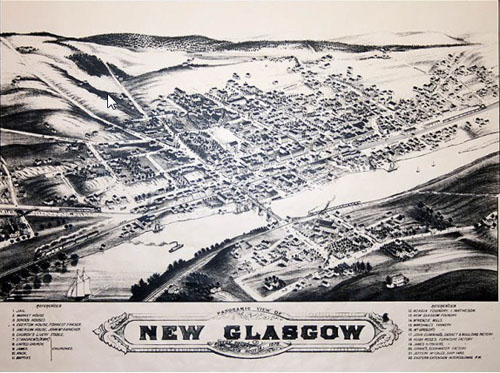
Saskatchewan – The Government of Saskatchewan has given a $400,000 grant to the University of Saskatchewan to begin digitizing and preserving online the province’s historic culture and heritage. The expectation is this will lead to online websites that will be of use to anyone with Saskatchewan ancestors. [Launch of Saskatchewan Heritage Digitization Project]
Manitoba – The University of Manitoba has begun the process of digitizing some 300 local history books about pioneers from various rural parts of Manitoba. The first book to be digitized will be on Rosser called “The First Hundred Years: 1893-1993”. As the rural history books are digitized, they will be put on the website Manitobia. Access is free. [Rural Manitoba Pioneer History Books
2011 January to March
Ontario – Halton County, Ontario has launched a digital newspaper archive. Halton, which is just west of Toronto covers the area of Burlington, Oakville, Milton and several other towns. The archive contains digital copies of many of the community newspapers in Halton as well as an index of births, marriages and deaths. The website contains over 235,000 genealogical records in total. The Advanced Search function on the website allows searches by name, date range and geographic location. Access is free. [Halton County Ontario Newspaper Archive]
Vancouver – The City of Vancouver Archives has digitized and put online about 400 panoramic cityscapes of Vancouver from the early 1900s. Historic panoramic photographs are rare and some of these will be of interest to genealogists (see image below). The photographs are part of a broader collection of 68,000 photographs that the City of Vancouver Archives has already put online (with an additional 1.4 million images still to be digitized). Access is free. [Historic Panoramic Photographs of Vancouver] [City of Vancouver Photo Archives] Other online historic images of Vancouver can be found in the Vancouver Public Library collection (250,000 images), the B.C. Archives collection (100,000 images) and the University of B.C. digital collection (56,000 images). Access to all these collections is free. [Vancouver Public Library Historic Photographs] [B.C. Archives Historic Photographs] [UBC Digital Archive Photographs]

Ottawa – Ancestry has put online the cemetery register for Beechwood Cemetery in Ottawa. The collection of more than 115,000 names spans the period from 1873 to 1990. In April 2009, Beechwood Cemetery officially became the national cemetery for Canada. Beechwood is also home to the National Military Cemetery and the RCMP National Memorial Cemetery. Many famous Canadians are buried in the cemetery, including former Prime Minister Robert Borden and Sir Sanford Fleming, the creator of standard time. Access is by subscription. [Historic Beechwood Cemetery Records] The Ottawa Branch of the Ontario Genealogical Society also sells a CD containing similar information. [Ottawa Branch of the Ontario Genealogical Society]
Ontario – A not-for-profit group called KnowledgeOntario has initiated a community digitization project to preserve and display historic content in a digital format. More than 33,000 digital files have already been completed with everything from historic photographs to life stories to vintage diaries. The information can be searched via Our Ontario, the main digital archive for culture and heritage in Ontario. Access is free. [Our Ontario]
Ontario – FamilySearch has created an index of 360,000 Ontario marriages from 869 to 1927. Note this is an index only. Access is free. [Historic Ontario Marriage Index]
Quebec – The PRDH database has been updated with 238,000 more records and now covers the period 1621-1799 (previously, it only went to 1779). The PRDH (Le Programme de recherche en démographie historique) database is a computerized population register of Quebec from the beginning of French colonization. This exhaustive database has been constructed from various parish records. The site is run by the University of Montreal and it is a must-visit website for anyone with Quebec ancestors. Access is free to search and view the first level results. Fees apply to see the detailed results [PRDH Historic Quebec Genealogy Records]
National – Library and Archives Canada (LAC) has put online the Canada Gazette. This is the official newspaper of record for the federal government. The purpose of the Canada Gazette (which is still being published) is to inform Canadians of the operations of the government. Below is an historic example announcing the death of Queen Victoria. The Canada Gazette is full of information that can be useful to genealogists. A partial list would include:
• Naturalization lists from 1915 to 1951 (covering over 700,000 immigrants).
• Divorce application lists from federal courts.
• Military promotion lists for World Wars I and II.
• Landowner lists for select cities.
The searchable online database for the Canada Gazette goes back to 1841 and 95% of the issues have already been put online. Access is free. [Canada Gazette Historic Database]
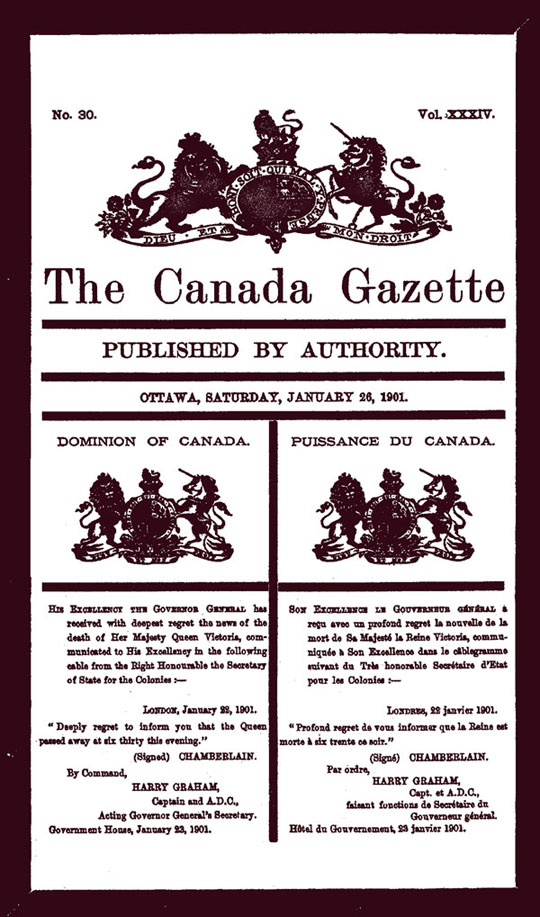
2010 October to December
Prairies – Library and Archives put online the special census that was carried out for the Prairie Provinces in 1916 (essentially current-day Alberta, Saskatchewan and Manitoba). Access is free but please note this database is not searchable by family name. Instead, you search by province, district name, district number and sub-district number. This approach makes it very hard to search unless you know exactly where your ancestor lived according to the census region. A much easier approach we found was to go to the search page and select the province and then under keyword enter the town or municipality name. This will still require a significant amount of manual searching through large pdf documents, but there is a wealth of information available if you do find your ancestors. The 1916 Prairie census lists the name of each household member; military service; town or municipality; relationship to head of the household; sex; marital status; age; country or place of birth; religion; year immigrated to Canada; nationality; race; languages spoken; reading and writing ability; occupation and employment. [1916 Census Records of Alberta, Saskatchewan, Manitoba]
National – Library and Archives Canada (LAC) revamped their genealogy website to make it easier for genealogists to find their ancestors. The revamped Canadian Genealogy Centre website provides tips and information on how to search through the website’s various genealogy databases. As well, a new database was added. Called the Upper Canada Land Board (1765 to 1804), it contains more than 16,000 references to documents dated between 1765 and 1804. These Land Board documents relate to the settlement of the districts of Hesse, Luneberg, Mecklenburg and Nassau, which are now all part of Ontario. The Canadian Genealogy Centre is by far the most important genealogy website in Canada. Access is free. [Canadian Genealogy Centre] Most of the databases can also be searched through the free Genealogy Search Engine.
National – Library and Archives Canada (LAC) released a set of Second World War photographs on Flickr. This adds to the LAC collection of images available through Flickr. Other image sets of interest to genealogists include Irish immigration to Canada, early Chinese Canadians and historic images of immigration facilities at Grosse Île. The site is free and allows people to comment and share content. [Library and Archives Canada Genealogy Photographs]
Ontario – The Toronto branch of the Ontario Genealogical Society has created a database of Toronto-area students and teachers who volunteered for active service in World War I and II. The database currently contains over 20,000 names and it is expected to grow. Access is free. This site also contains excellent links to various Canadian military records of interest to genealogists. [Toronto School War Memorials]
National – Ancestry has put online various Canadian military records from the First World War. Included are such items as attestation papers and burial records for fallen soldiers. Access is by subscription. [Canadian Military Records] The vast majority of these records are already available for free on various Canadian government websites and can also be searched at no cost on the free Genealogy Search Engine.
Quebec – Ancestry.ca has added a new index of all persons who received government land grants in the province of Quebec between 1763 and 1890. Over 34,000 names are included in the index, which lists the name of the grantee, county and township of the grant and number of acres. Only the initial land grant is listed in the index. Any successive divisions or sale of the land is not included in the index. The reference number in the index can be used to view the complete letter patent (which often contains valuable genealogical information) held at the Quebec Archives. Access is by subscription. [Historic Quebec Land Grants]
National – Library and Archives Canada (LAC) has launched a new and improved version of the online database Canadian Naturalization 1915-1951. This database contains reference to people who became naturalized Canadians during the period. According to LAC ``this database is one of the few Canadian genealogical resources specifically designed to benefit researchers having roots other than British``. The database can be searched by name and date. Access is free. [Canadian Naturalization Database]
Ontario – Library and Archives Canada (LAC) has created a new online database called Upper Canada Land Petitions (1763-1865). This database provides reference to 77,000 petitions for land grants in present-day Ontario between the years 1763 to 1865. According to LAC, “many early settlers, both military and civilian, submitted petitions to the Governor to obtain Crown land”. Typical petitions would include military discharge certificates, United Empire Loyalists fleeing the American Revolutionary War and reparations to Upper Canada citizens who had suffered loss during the War of 1812. Note this database only indexes the petitions. The actual petitions are not online. Still, it is worth checking for anyone who had ancestors that settled on a farm in Ontario between 1783 to 1865. Access is free. [Upper Canada Land Petitions 1763-1865]
2010 July to September
Ontario – Over 32,000 new names have been added this year for the burial registers of the Toronto Trust Cemeteries (now known as the Mount Pleasant Group of Cemeteries). The online records range from 1826 to 1935. This is a collaborative project between the Ontario Genealogical Society and FamilySearch. Access is free. This project is looking for more volunteers to transcribe records in case you have ancestors from the Toronto region. [Toronto Trust Cemeteries Project]
National – Library and Archives Canada has put online records of passenger ship manifests listing all ship passengers for the period 1925 to 1935 for most of the major Canadian port cities (North Sydney, Halifax, Saint John, Quebec City, Montreal, Vancouver and Victoria). These digitized records have been copied from microfiche and microfilm and are currently not searchable by name or keyword. The records, however, are organized by port city and arrival date so it is possible to scan through multiple pages if you know the port city and approximate arrival date of your ancestor. Access is free. [Canadian Ship Passenger Manifests 1925 to 1935]
BC– The University of B.C. has set up a new Chinese-Canadian history website called Chinese-Canadian Stories. The purpose of the website is to create a digital archive of stories by Chinese Canadian immigrants. The site was paid for by the federal government as part of a program to make amends for the so-called ‘head tax’ imposed on Chinese immigrants from 1885 to 1923 and the near-complete ban on Chinese immigration from 1923 to 1947. This site does not officially launch until 2012. However, given the advanced age of many of the expected participants, family members who wish to contribute a story may wish to do so now. Access is free. [Chinese Canadian Stories]
National – Ancestry has released a searchable compilation of Canadian military officer records that span the years 1863 to 1939. The compilation is an aggregation of several Canadian Forces lists, which combined can allow a researcher to trace the military career of an officer during Canada’s formative years. The records include such details as name, rank, unit, date & place of service and dates of promotion. The lists do not include enlisted men, only officers. Access is by subscription. [Canadian Historic Military Records 1863-1939]
Ontario – Library and Archives Canada has put online 113 historic fire insurance maps for the city of Ottawa dated January 1888. Fire insurance maps can be particularly valuable for genealogists tracing their ancestor’s homes because these maps show the location and structure of individual buildings on a block-by-block basis. These fire insurance maps are particularly well done and they are enjoyable to browse if you happen to be from Ottawa. Access is free. [Historic Ottawa Fire Insurance Maps]
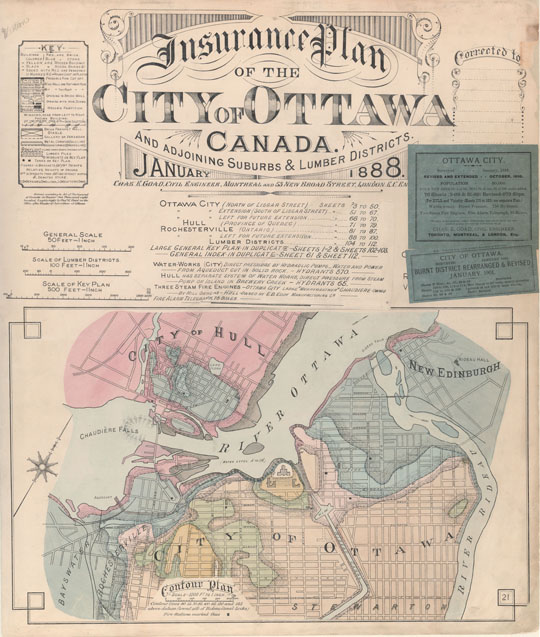
2010 April to June
National – Library and Archives Canada (LAC) has put online a new photo album entitled Pride and Dignity that includes a photo essay of Aboriginal portraits, such as Louis Riel (see image below). LAC maintains several historic photo collections on Flickr portraying various aspects of Canadian history. Access is free. [Historic Canadian Aboriginal Photographs]
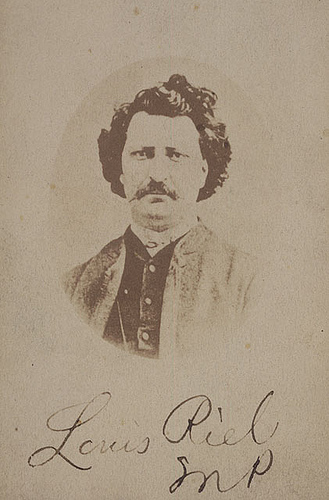
National – Ancestry has expanded their Canadian City and Area Directories collection with another 150,000 pages. The collection covers the period 1819 to 1906 and some seven million names are listed in total. Access is by subscription. [Historic Canadian City Directories 1819-1906]
Nova Scotia – Ancestry has put online one million Nova Scotia birth (1863-1907) marriage (1763-1932) and death (1864-1877, 1890-1957) records. The index can be searched by name, place of birth, place of marriage, place of death and (for marriage records) name of spouse. The database was constructed in partnership with the Nova Scotia Archives. Access is by subscription. [Historic Nova Scotia Birth Marriage and Death Records]
Original records can also be purchased at [Nova Scotia Historical Vital Statistics]. If you do not have an Ancestry subscription and you only want one or two records, you might be better off going directly to the government website.
National – Library and Archives Canada has begun digitizing and putting online service records of First World War Canadian soldiers. Attestation papers for WWI enlistment were previously put online. If a service record for your ancestor has not yet been digitized then you can request a paper copy for a small fee and the digitized copy will be uploaded to the website concurrently. Access is free. [Canadian World War I Service Records and Attestation Papers] These service records can also be searched using the free Genealogy Search Engine.
Ontario – Ancestry has updated their collection of Ontario birth (1869-1909) and death (1869-1934) records. Access is by subscription. [Historic Ontario Birth and Death Records 1869-1934]
National – Library and Archives Canada has put online a database of 660,000 records of the National Bibliography of Canada that was previously only available on CD. The database contains listings of a wide variety of publications produced in Canada or about Canada. This includes books, periodicals, sound recordings, video recordings, music scores and more. The database can be searched by author and title. This is a good place to track down rare genealogy source documents. Access is free. [Historic Canadian Publications Database]
National – The University of Toronto library has digitized 250,000 books in its collection and made it available through the Internet Archive. The Internet Archive now has some 2.3 million books online that are searchable for genealogical information. Access is free. [University of Toronto Digitized Book Collection]
2010 January to March
National - Athabasca University has put online a beta website with images of historical multicultural newspapers found across Canada. The collection currently includes Croatian, Estonian, Finnish, Hungarian, Polish, Serbian, Ukrainian, Yugoslavian, Latvian and Lithuanian newspapers. Access is free. [Historic Canadian Ethnic Newspapers]
Canada – Google’s News Archive has put online 2.5 million articles from the Ottawa Citizen going back as far as 1890. This searchable archive is free, but it should be noted that there appears to be some time gaps in the coverage. As shown below, simply enter the Source as “Ottawa Citizen” (highlighted in red) and then your search terms (highlighted in green). [Ottawa Citizen Newspaper Archive 1890 to Present]
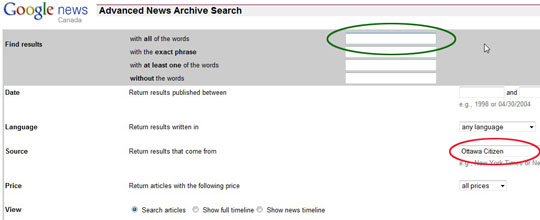
2009 October to December
New Brunswich: The New Brunswich Provincial Archives website has put online 65,000 new government documents from 1786 to 1833. This website contains about 1.8 million records, including historic vital statistic records (birth, marriages, etc.) [Historic New Brunswich Birth, Marriage, Death Records 1786-1833]These records can all be searched using the free Genealogy Search Engine.
2009 July to September
National: Ancestry.ca has added more than 100,000 British and Canadian prisoner of war records of soldiers held by Germany in World War II. In addition, the UK Army Roll of Honour has also been added, which includes 170,000 records of all British Army personnel killed in action during World War II. Access is by subscription. You can get a free trial subscription to the main site Ancestry.com by filling out the form below. [Canadian World War II Prisoner of War Records]
National: Library and Archives Canada has significantly upgraded their database containing references to immigrants who became naturalized Canadian citizens from 1915 to 1932 inclusive. The database now contains over 206,000 references. Access is free. [Historic Records on Naturalized Canadian Citizens 1915-1932]
Alberta: The city of Edmonton has expanded and relaunched their online photo archive. The collection currently has over 25,000 photographs with more to come. Access is free. A fee applies to order prints. [Historic Edmonton Photo Archive]
2009 April to June
National: Library and Archives Canada has put online nine Canadian censuses from 1851 to 1916. The censuses contain over 32 million names and 1.3 million images of the original records. Some of the censuses are searchable only by geographic region (and not by family name). Access is free through the Library and Archives website. [free Canadian Census Records]
National: FamilySearch.org has put online the Canadian 1851, 1861, 1871 and 1881 censuses. The 1891 Canada census will be added shortly. Access is free. [free Canadian Census Records]
Ontario: Starting 1 June 2009, Ontario will allow access to 250,000 adoption records available since 1921. Ontario follows B.C., Alberta, Manitoba and Newfoundland in allowing access to adoption records. [Ontario Adoption Records]
National: FamilyRelatives.com has put online 200,000 Canadian civil service records from 1872 to 1918. The records contain the civil servant's name, position, department, length of service, salary and date of appointment. Access is by subscription. [Historic Canadian Civil Service Records 1872-1918]
National: Ancestry.ca has released 1.6 million records of people who officially immigrated from the US to Canada from 1908 to 1935 (prior to 1908 the border was open and the Canadian government did not track immigration from the US). Note: these are immigration records and do not include Canadians returning home. Access is by subscription. [US to Canada Emmigration Records 1908-1935]
Manitoba: The Manitoba Library Consortium has launched a digital collection of various Manitoba Newspapers ranging mainly from 1870 to 1920. Included is The Winnipeg Tribune (once one of Winnipeg's main newspapers) available from 1890 to 1980. Birth and obituary notices are searchable by name. The site also contains some historical photographs and maps. Access is free. [free Manitoba Newspaper Archive 1870-1920]
2009 January to March
Ontario: The Archives of Ontario will be moving to a new purpose-built facility at 4700 Keele Street in Toronto. The modern glass building (see photos) on the York University campus will be opening Thursday April 2, 2009. The Archives of Ontario is the official repository of provincial government records in Ontario. [Archives of Ontario]
Prairies: Ancestry.ca has launched the 1916 census of Alberta, Saskatchewan and Manitoba. From 1906 to 1956, the Prarie provinces had a separate census taken every five years after the national census. The searchable database includes 1.7 million names and over 38,000 images of the original census pages. Information includes first name, last name, year of birth, place of birth, father's name, mother's name, spouse's name and military service. Access is by subscription. [1916 Alberta, Saskatchewan, Manitoba Census]
National: Library and Archives Canada has launched online the 1891 Canadian census. This was the third national census in Canada and contains the name, gender, age, marital status and town/district of viritually all citizens of Canada. Library and Archives Canada is also rolling out a unique feature where genealogists can suggest a correction to a record that may have been transcribed incorrectly (an image of the original census form is included with each record). Access is free. [free 1891 Canadian Census]
National: Ancestry.ca has launched a special learning centre in honour of Black History month. The database contains public and private records on over 800,000 black Canadians. Some of the records date back to before Confederation. Access is by subscription. [Black Canadian Archive]
National: Library and Archives Canada has added about 1 million passenger list records to its database for all passengers arriving at Quebec city between 1865 to 1900. Quebec city was the main point of entry to Canada for European immigrants. The database lists such items as the name of the person, age, country of origin and occupation, as well as the name of the ship, departure port, departure date, arrival port, arrival date and the final destination of each passenger. Many immigrants to the United States also passed through this port (it was often cheaper to sail to Canada and then travel south by land). Access is free. [free Historic Canada Passenger Records 1865-1900]
2008
BC: The Times Colonist newspaper of Victoria, B.C. has put online the first 50 years of their news archive covering the period 1858 to 1910. This covers the period when Victoria was the largest city in B.C. Access is free. [free Victoria Times Colonist Newspaper Archive]
National: Library and Archives Canada has reconstructed available vessel passenger lists for the period 1803-1865 for immigrants to Canada. The information has been stored in a searchable database. Access is free. [free Canada Immigration Records 1803-1865]
National: Ancestry.ca has put online Canadian city and area directories for the period 1819-1899. These directories were precursors to modern-day phone books and list the name, address and occupation of people in various towns and cities across Canada during the 1800's. Access is by paid subscription. [Historic Canada City Directories 1819-1899]
Quebec: Library and Archives Canada has prepared a web site on Grosse Île. Quebec city was the main port of entry to Canada in the 1800's and Grosse Île served as the quarantine centre from 1832-1937. The web site contains many historical documents and a searchable database (and ability to view the original documents in digitized form). About 2/3 of the immigrants who were quarantined on Grosse Île were from Ireland, where they were fleeing major cholera and smallpox epidemics in their homeland. Access to the database is free. [free Grosse Ile historic Immigration Records]
National: Ancestry.ca has digitized the enlistment (attestation) records of 600,000 Canadians who enlisted in World War I (1914-1918). The records contain the name, age, place of birth, physical description and next of kin. A few records also contain additional information, such as occupation, marital status and residence. Access is by paid subscription. [World War I Attestation Papers]

